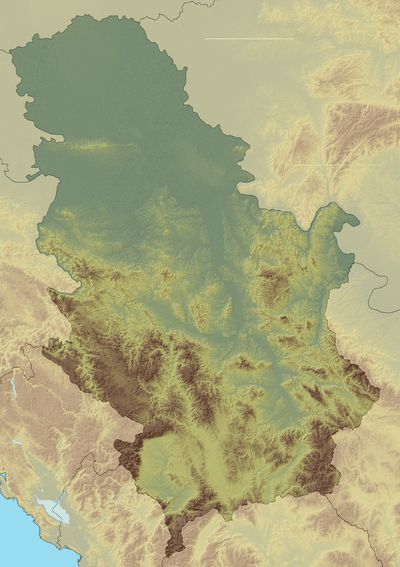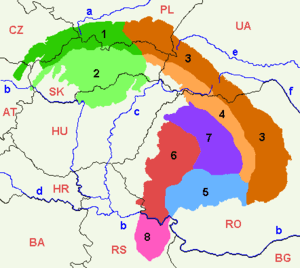Kučaj
| Kučaj | |
|---|---|
 | |
| Highest point | |
| Elevation | 1,284 m (4,213 ft) |
| Coordinates | 44°04′48″N 21°49′41″E / 44.08000°N 21.82806°ECoordinates: 44°04′48″N 21°49′41″E / 44.08000°N 21.82806°E |
| Geography | |
 Kučaj Location in Serbia | |
| Location | Eastern Serbia |
| Parent range | Serbian Carpathians |
Kučaj (Serbian Cyrillic: Кучај, Кучајске планине, pronounced [kût͡ʃaj]) is a mountain range in eastern Serbia. Its highest peak, Velika Tresta has an elevation of 1,284 meters above sea level.[1] They belong to the Serbian extension of Carpathians, which separate the valleys of Great Morava and Timok.
The area is a plateau in form, of complex tectonic and morphological structure, subdivided by the river valleys. One of the main features is the Resava Cave. North of Resava Cave is the natural monument Lisine, which comprises two waterfalls, Veliko Vrelo and Veliki Buk.[2] The Lisine hydro-complex and Resava Cave are under one administration. In 2017 the Government of Serbia and Institute for Nature Protection began preliminary actions into creating a new national park, which would cover the mountainous Kučaj-Beljanica region. It is supposed to be the sixth and the largest national park in Serbia encompassing the Resava Cave, Lisine complex and some of the oldest, intact forest in the country, like the Vinatovača rainforest, which remained intact since the mid 17th century.[3][4]
Veliki Buk (or Lisine) waterfall is located in the watershed of the Resava River in east Serbia. It is carved in the karst area, where the sinking river of Resava springs again from the ground in the canyon-type valley of Sklop.[5] The waters springs from the karst spring Veliko Vrelo, forming a short stream of the same name which falls into the Resava. With the height of 25 m (82 ft), it was considered the highest waterfall in Serbia until the 1990s when the higher waterfalls were discovered on the Kopaonik and in the Visok region of the Stara Planina. The waterfall is situated at an altitude of 450 m (1,480 ft) and 20 km (12 mi) east of Despotovac. It is formed on the tufa rocks and the water falls into the 5 m (16 ft) deep lake. In August 2017 the waterfall was embellished with the color-changing decorative lights, becoming the first hydrology object in Serbia with such lights. The access roads are arranged with several restaurants but as of 2017 there is no mobile phone signal in the area, which the local tourist guides say is "probably a positive thing". There is also an stream water mill, "Mija's watermill" within the complex. It is built in 1918 and is still operational, though it is adapted into the tourist attraction, equipped with the objects from the century ago.[4]
References
- ↑ "Velika Tresta - 1284m, 6 points". SOTA.
- ↑ "Lisine" (in Serbian). JP Resavska pećina. 2014.
- ↑ Z.Gligorijević (22 April 2017), "Resavska pećina otvorena pre 45 godina", Politika (in Serbian), p. 12
- 1 2 G.Zorkić (6 August 2017), "Kutak za romantike", Politika-Magazin, No. 1036 (in Serbian), p. 25
- ↑ Jovan Đ. Marković (1990). Enciklopedijski geografski leksikon Jugoslavije (in Serbo-Croatian). Sarajevo: Svjetlost. ISBN 86-01-02651-6.
External links
| Wikimedia Commons has media related to Kučaj. |
